Choosing the right table lamp shade size enhances lighting efficiency and aesthetic appeal. This guide helps you select the perfect fit based on room size, lamp base, and personal style.
1.1 Importance of Choosing the Right Shade Size
Choosing the right table lamp shade size is crucial for both functionality and aesthetics; A properly sized shade ensures optimal light distribution, preventing harsh glare or insufficient illumination. It also maintains the lamp’s visual balance, enhancing the overall decor. Incorrect sizing can make a lamp appear disproportionate, detracting from the room’s harmony. Additionally, the right shade size impacts the lamp’s usability, especially for task lighting, where focused light is essential. A well-chosen shade complements the lamp base and room style, creating a cohesive design. By selecting the appropriate size, you achieve a blend of practicality and visual appeal, making your space more inviting and functional. This guide helps you navigate the process with confidence, ensuring your table lamp serves its purpose while elevating your interior design.
1.2 Brief Overview of Table Lamp Shade Styles
Table lamp shades come in a variety of styles, each offering unique aesthetic and functional benefits. Drum shades are cylindrical and provide broad light coverage, while bell shades taper slightly, creating a classic look. Empire shades are wider at the bottom and narrower at the top, ideal for ambient lighting. Coolie shades, with their conical shape, direct light downward, making them perfect for task lighting. Cylinder shades offer a sleek, modern appearance, often used in minimalist designs. Each style complements different decor, from traditional to contemporary settings. Understanding these styles helps you align your shade choice with your room’s design and lighting needs, ensuring both functionality and visual appeal. This overview provides a foundation for selecting the perfect shade to enhance your space’s ambiance and functionality.
Understanding Table Lamp Shade Measurements
Accurate measurements of height, width, and slant ensure proper fit and aesthetics. Use a tape measure to determine dimensions, ensuring alignment with the lamp base and room decor.
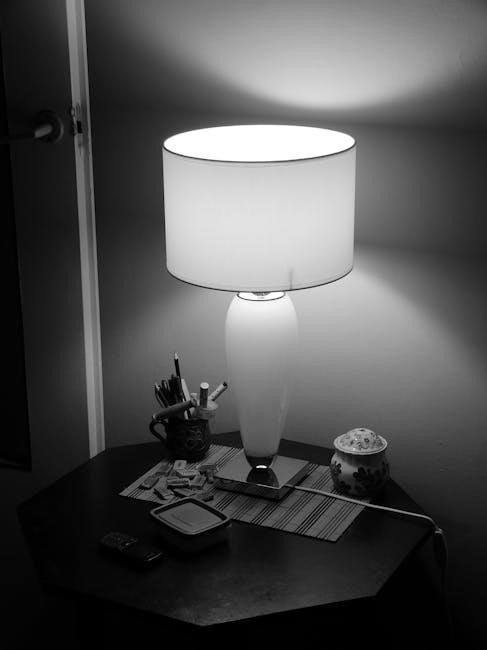
2.1 Key Measurements: Shade Height, Width, and Slant
When selecting a table lamp shade, understanding key measurements is crucial. Shade height refers to the vertical length from the top to the bottom rim. Width is measured across the shade’s widest point, while slant indicates the angle at which the shade tapers. These dimensions ensure proper fit and alignment with the lamp base. For example, a tall, narrow shade may suit a slender base, while a wide, short shade complements a broad base. Accurate measurements prevent oversized or undersized shades, which can disrupt the lamp’s functionality and aesthetic balance. Always measure the existing shade or base to determine the ideal proportions for your space. Proper alignment enhances lighting efficiency and visual harmony, making these measurements essential for a polished look.
2.2 How to Measure Your Table Lamp Base
Measuring your table lamp base is essential for selecting the right shade size. Start by determining the base’s diameter, which is the widest part of the lamp’s foundation. Use a ruler or measuring tape to measure across the base from one edge to the other. Next, measure the height of the base from the bottom to the top where the shade will sit. Additionally, consider the overall width of the lamp, including any decorative elements. These measurements help ensure the shade proportions align with the base, creating a balanced look. For accurate results, measure in inches or centimeters and note the dimensions for reference. Proper measurements prevent mismatched sizes and ensure the shade fits securely, enhancing both functionality and aesthetics. Always double-check your measurements for precision.
2.3 Understanding the Role of the Harp and Finial
The harp and finial are crucial components in securing a table lamp shade. The harp is a metal frame that sits atop the lamp base, holding the shade in place. Its size and shape must align with the shade’s dimensions for proper fit. The finial, typically a decorative knob, screws onto the harp, ensuring the shade is securely fastened. When measuring for a new shade, consider the harp’s height and width to ensure compatibility. A correctly fitted harp and finial prevent the shade from wobbling or sitting unevenly. They also play a role in the lamp’s aesthetic, as the finial can add a decorative touch. Always check the harp’s size against the shade’s inner diameter for a seamless installation. Proper alignment ensures both functionality and visual appeal, making the harp and finial essential for a polished look.

Determining the Right Shade Size for Your Lamp
To determine the right shade size, consider the lamp’s base measurements, the shade’s height, width, and slant, and the room’s lighting needs. Proper fit ensures functionality and style.
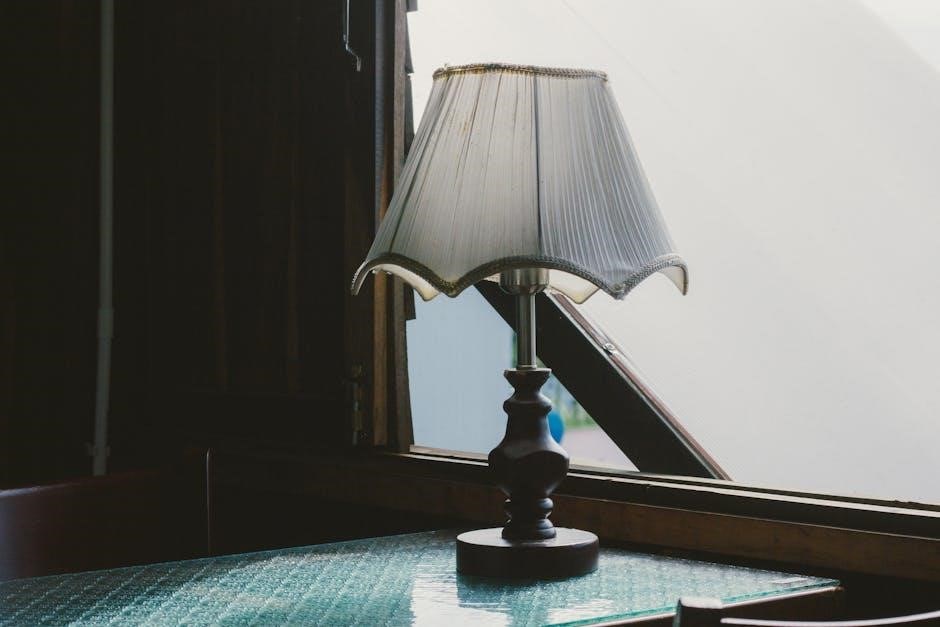
3.1 Shade Size Based on Lamp Use (Task vs. Ambient Lighting)
When selecting a shade size, consider the lamp’s primary function. For task lighting, such as reading, a smaller, more focused shade is ideal to direct light precisely. This ensures sufficient brightness without spreading light too widely, maintaining efficiency for specific tasks.
Ambient lighting, however, benefits from a larger shade to diffuse light evenly across a room. A wider shade softens the light, creating a relaxing atmosphere while minimizing harsh shadows. The shade’s size and shape should align with the intended use to achieve the desired lighting effect.
By matching shade size to the lamp’s purpose, you optimize both functionality and aesthetic appeal, ensuring the space is well-lit and visually harmonious.
3.2 How to Choose the Right Shade Size for Your Room
Choosing the right shade size for your room involves considering the space’s dimensions and decor. Measure the room to determine the optimal shade width and height. A larger room typically requires a bigger shade to ensure adequate lighting, while smaller spaces benefit from more compact shades to maintain balance.
Consider the lamp’s placement and the room’s natural light. If the lamp is a focal point, a larger shade can enhance its presence. For subtle lighting, a smaller shade may be more appropriate. Ensure the shade aligns with the room’s aesthetic, whether modern, traditional, or minimalist.
Test the shade in the room to see how it affects light distribution and ambiance. This ensures the chosen size complements the space and meets your lighting needs effectively.
3.3 Common Shade Sizes and Their Applications
Common table lamp shade sizes range from small, medium, to large, each serving specific purposes. Small shades (6-10 inches in width) are ideal for task lighting, such as reading lamps. Medium shades (10-14 inches) are versatile and suit most table lamps, providing balanced ambient light. Large shades (14-18 inches or more) are often used for decorative purposes or in spacious rooms to make a statement.
Specialty sizes, like extra-large shades (over 18 inches), are perfect for high ceilings or unique lamp designs. Drum shades and bell shades are popular choices, with drum shades offering a modern look and bell shades adding a classic touch. The size and style should complement the lamp base and room decor to ensure functionality and aesthetic harmony.

Factors Influencing Shade Size Selection
Room size, lamp base proportions, and personal style significantly impact shade size choices. Lighting needs and decor also play a role in selecting the ideal shade.
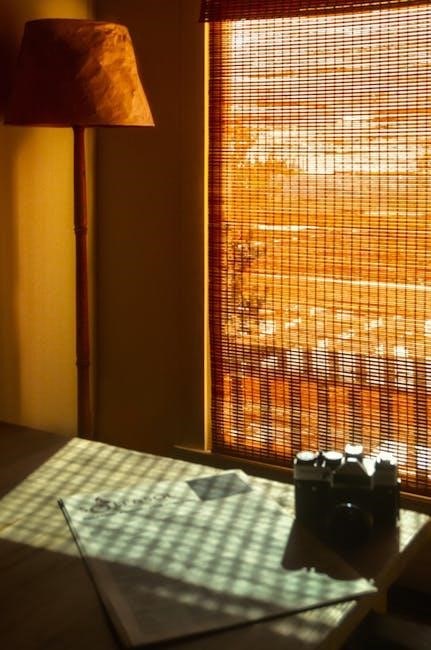
4.1 Room Size and Lighting Needs
Room size and lighting needs are crucial factors in selecting the right shade size. Larger rooms require bigger shades to ensure adequate light coverage, while smaller spaces benefit from more compact designs. The intended use of the lamp—whether for task lighting or ambient illumination—also plays a significant role. Task lighting demands a shade that focuses light precisely, such as a narrower or more directional design. Conversely, ambient lighting requires a shade that diffuses light softly, often larger and more rounded. Balancing these elements ensures the lamp meets both functional and aesthetic requirements, creating a harmonious and effective lighting solution for any space.
4;2 Lamp Base Size and Proportions
The size and proportions of the lamp base significantly influence the choice of shade. A shade that is too large or too small can disrupt the balance of the lamp’s design. Generally, the shade should be proportionate to the base’s height and width. For example, a tall, slender base pairs well with a narrower shade, while a shorter, bulkier base requires a wider shade to maintain visual harmony. Additionally, the base’s design, such as ornate details or a minimalist aesthetic, should guide the shade’s style and scale. Ensuring the shade aligns with the base’s dimensions and style creates a cohesive look, enhancing both functionality and decor. Proper proportion ensures the lamp remains a functional and attractive element in any room.
4.3 Decorative Style and Aesthetic Preferences

Decorative style and personal taste play a crucial role in selecting the perfect table lamp shade. The shade’s design, shape, and material should complement the lamp’s base and the room’s overall aesthetic. For instance, a modern lamp base pairs well with sleek, minimalist shades, while a vintage base might suit a more ornate or textured shade. Color and pattern choices also matter, as they can enhance or clash with the room’s decor. Bold patterns and vibrant hues work well in eclectic spaces, whereas neutral tones and simple designs align with minimalist interiors. Additionally, the shade’s material, such as linen, glass, or metal, can add depth and visual interest. Ultimately, the shade should reflect the user’s style while maintaining functionality, ensuring the lamp becomes a harmonious part of the room’s design.

How to Measure and Fit a Table Lamp Shade
Measure the lamp’s base and existing shade to ensure a proper fit; Use a ruler to check height, width, and slant for alignment and functionality.
5.1 Measuring the Existing Shade for Replacement
To measure the existing shade, start by recording its height from the bottom to the top edge. Next, measure the width across the shade’s widest point. For rounded shades, use a flexible tape measure to ensure accuracy. Note the slant height if the shade is conical or tapered. Additionally, measure the fitter size, which is the diameter of the inner ring that attaches to the lamp base. Ensure all measurements are precise to find a perfect replacement. If the shade is asymmetrical, take multiple measurements to confirm dimensions; Accurate measurements guarantee a proper fit and optimal lighting performance. For unusual shapes, consider consulting a professional for guidance. Proper measurement ensures the new shade aligns seamlessly with the lamp base and maintains its intended functionality and aesthetic appeal.
5.2 How to Ensure Proper Fit and Alignment
To ensure a proper fit and alignment, start by comparing the measurements of the new shade with the existing one or the lamp base. Use a flexible tape measure to check the fitter size, ensuring it matches the harp or socket. For rounded shades, verify the diameter at the widest point aligns with the base. If replacing an asymmetrical shade, mark the attachment points to ensure alignment. Once installed, gently rotate the shade to confirm it sits evenly. Check the vertical alignment by ensuring the shade is level and not tilted. Test the lamp’s stability to prevent wobbling. Finally, visually inspect the shade’s position relative to the base and surrounding decor to maintain aesthetic balance. Proper fit and alignment ensure both functionality and visual appeal, making the lamp a cohesive part of the room’s design.
Common Mistakes to Avoid When Choosing a Shade
Avoid oversized or undersized shades that disrupt proportions. Ignoring the lamp’s intended use can compromise functionality. Always measure carefully and consider the lamp’s purpose before selecting.
6.1 Oversized or Undersized Shades
Oversized shades can overwhelm a space, creating an unbalanced look and potentially harsh lighting. Undersized shades may fail to provide adequate light coverage, making the lamp appear out of proportion. Both mistakes can negatively impact the room’s ambiance and functionality. Proper measurements are crucial to ensure the shade complements the lamp base and room decor. Always consider the lamp’s intended use and the space where it will be placed. Measuring the base and understanding the room’s dimensions can help avoid these common errors. A well-sized shade enhances both aesthetics and lighting efficiency, making it essential to get it right. Avoid guesswork and use a tape measure for accuracy. Remember, the shade should harmonize with the lamp and its surroundings for optimal results.
6.2 Ignoring the Lamp’s Intended Use
Ignoring the lamp’s intended use is a common mistake that can lead to poor lighting results. Task lamps, for example, require focused light, while ambient lamps need a softer glow. Choosing a shade that doesn’t align with the lamp’s purpose can result in insufficient or excessive light. For instance, a shade too opaque on a reading lamp can make the light too dim, while a sheer shade on a decorative lamp may not provide the desired ambiance. Always consider whether the lamp is meant for task, ambient, or decorative lighting. Measure the lamp’s base and assess the room’s needs to ensure the shade complements its function. Proper alignment between the shade and the lamp’s intended use ensures optimal performance and aesthetic appeal. Avoid this mistake by aligning the shade with the lamp’s specific role in your space.
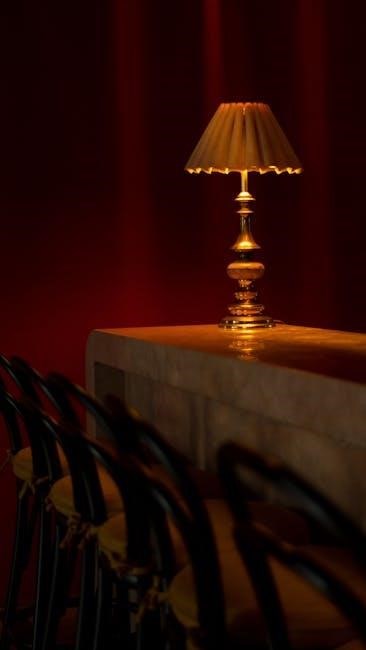
Selecting the right table lamp shade size ensures proper lighting and aesthetic harmony. Measure carefully, consider the lamp’s purpose, and align with your room’s decor for the perfect fit.
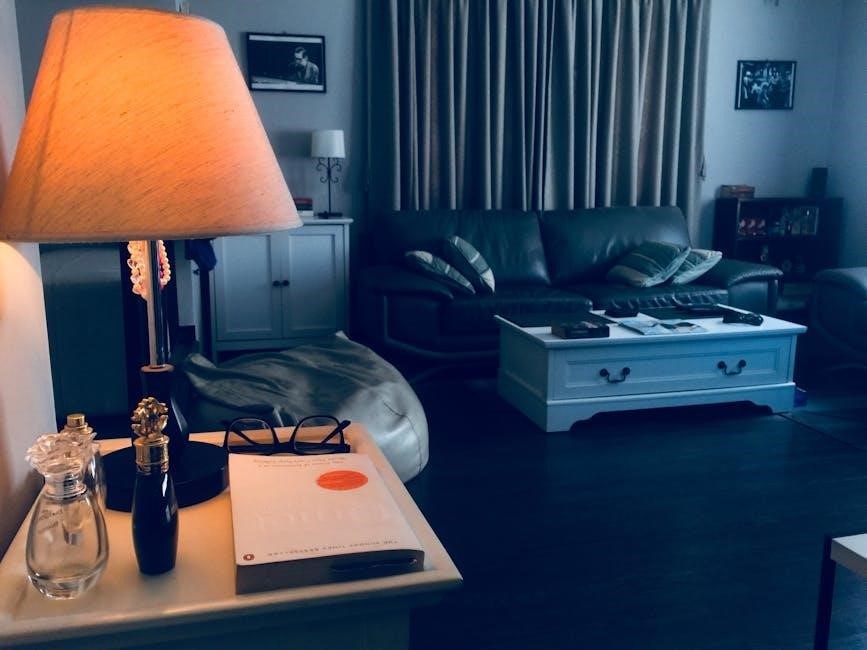
7.1 Key Takeaways for Selecting the Perfect Shade
When selecting a table lamp shade, accuracy is key. Measure the lamp base and existing shade to ensure proportionate fit. Consider the lamp’s purpose—task lighting requires focused light, while ambient lighting needs a softer glow. Reflect on the room’s decor and your personal style to align the shade’s design. Avoid common mistakes like oversized or undersized shades, which can disrupt the balance. Remember, the shade’s height and width should complement the base, and the harp and finial play a crucial role in securing the shade properly. By balancing functionality and aesthetics, you’ll find the ideal shade to enhance your space. Always double-check measurements and consider the lamp’s intended use before making a final decision.
7.2 Where to Find the Best Options for Your Needs
Exploring the right sources is essential for finding the perfect table lamp shade. Online retailers like Amazon and Wayfair offer a vast selection, while specialty stores such as Crate & Barrel and Pottery Barn provide stylish, high-quality options. For unique or vintage shades, consider platforms like Etsy or eBay. Home improvement stores like IKEA and Lowe’s also carry a variety of shades to suit different budgets and styles. Additionally, local lighting stores or interior design boutiques can offer personalized recommendations. When shopping, ensure the shade’s measurements and style align with your lamp base and room decor. Custom shade options are also available for those seeking a tailored look. By exploring these avenues, you can find the ideal shade to enhance your space’s functionality and aesthetic appeal.
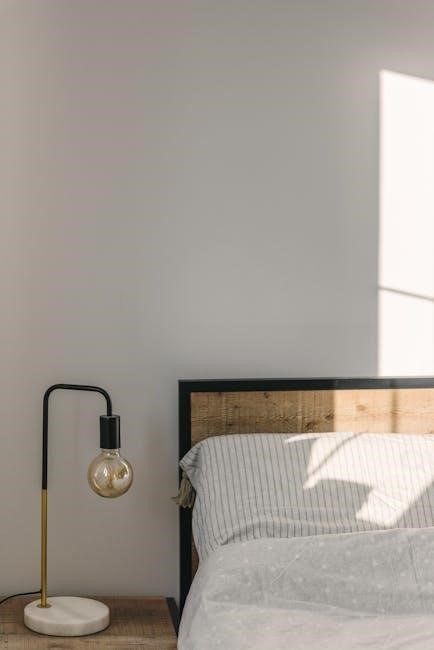
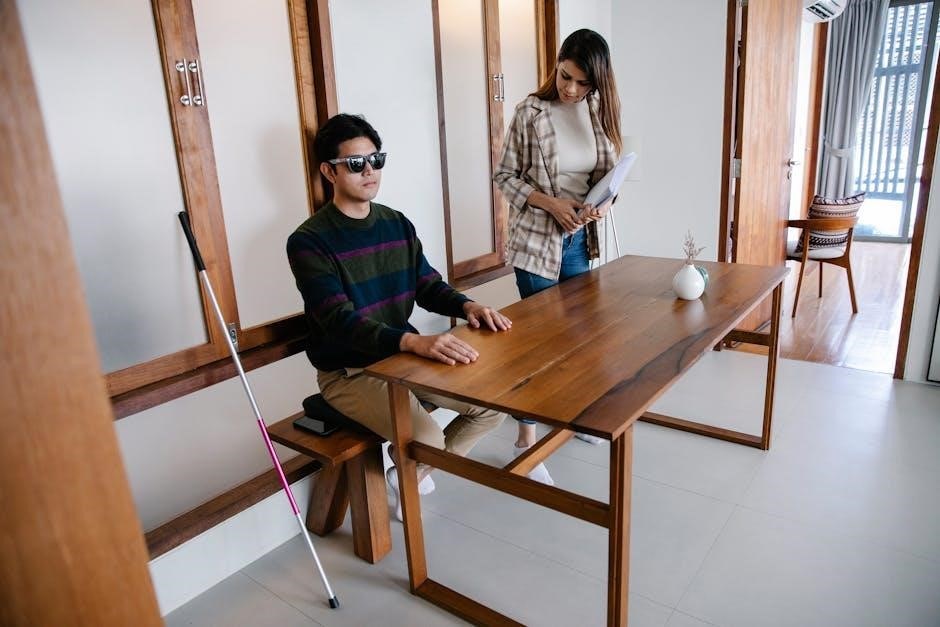


About the author